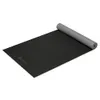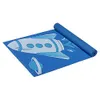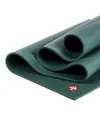
Dolphin push-ups torch your shoulders and work your core muscles, so I added 90 reps to my exercise routine every day for one week to see what, if anything, would happen to my body.
To do a dolphin push-up, you’ll start in a forearm plank position, then push through your shoulders, arms and elbows, lift your hips up and back toward the ceiling, as if you’re trying to perform a downward dog on your elbows, then return to a forearm plank position.
Best of all, I didn’t need any equipment to accept my own challenge — just one of the best yoga mats and my body weight. Here’s what happened throughout the week, 630 reps later.
How to do a dolphin push-up
Unlike dolphin planks, this dolphin exercise requires movement. Here’s a step-by-step guide to doing a dolphin push-up:
- Start in a forearm plank position with your shoulders stacked over your elbows, hips aligned with your shoulders and stomach braced.
- Slightly round your upper back and engage your glutes, quads and shoulders.
- Lift your hips and send them upward and backward while pressing through your elbows.
- Maintain a soft knee bend and stay on the balls of your feet.
- Send your shoulders forward and return to the forearm plank position.
I did 90 dolphin push-ups every day for one week — here’s what happened
Here’s what I learned.
It works your shoulders hard
I tried two variations throughout the challenge to emphasize my shoulders and triceps. To send more focus to the shoulders, I kept my hips lifted throughout and sent my weight over my shoulders as I pushed forward; it’s less taxing on the elbows to bring your hands together and slightly turn your elbows outward.
In the fitness industry, you’ll always find variations of the same exercise under the same name; this was much more challenging than regular dolphin push-ups, but to target my triceps more, I also tested out another tough alternative.
Starting in a downward dog position, I bent my elbows and tapped them down onto the mat, keeping them close to my ribs, then pushed back up into the starting position while lifting my hips (which can also be done from the knees).
A week’s worth of dolphin push-ups provided a pretty decent upper workout without weights.
It helped develop short-term hamstring flexibility
Although the exercise builds a range of motion and strength in your shoulders and to a lesser degree, targets your chest, upper back and abs, it also delivers a great stretch for the hamstrings.
Lifting your hips and sending your weight backward emphasizes your hamstrings and calves, helping to stretch them. There are other hamstring stretches I’d prioritize for developing lower body flexibility, but it’s a bonus and helped me find space down the backs of my legs as the reps went on.
It's harder than it looks
The bodyweight exercise might not look like much, but your muscles stay under constant tension throughout both phases of motion. Unlike the dolphin pose found in yoga, your muscles lengthen and shorten as they contract. Weight-bearing upper body exercises performed from a vertical position can feel intense even without weights.
Coupled with high reps, I found dolphin push-ups still delivered a familiar upper-body muscle-fatiguing burn that I associate with push-ups, without actually performing them. However, you'll need to try the second variation I mentioned earlier if you want to work your triceps hard.
Verdict
The beauty of this exercise is that it can be done anywhere, anytime and I could slot the reps into my day whenever I had time. Despite the high rep count, I didn’t notice any changes in my body except slightly more space in my hamstrings immediately afterward.
I didn’t expect to see any changes within a week, so this wasn’t about building muscle definition or making strength gains — more an experiment to learn more about my body and how it responds to endurance work.
I recommend breaking your reps up like I did, completing 20-30 reps at a time with a short rest between. Ticks all around for working my upper body hard and testing my endurance, but it wasn’t a game-changer to my exercise routine and I could still slot my regular runs, CrossFit classes and hot yoga routines into my day with little problem. That said, my elbows need a good rest.
More from Tom's Guide
- I'm a personal trainer who prefers strength training to bodyweight workouts — here's why I love this 20-minute calisthenics routine for beginners
- Stiff hips? This 5-move bodyweight walking workout builds flexibility and a stronger lower body
- I tried the 6-12-25 workout method for building strength with a single kettlebell — here's what happened
Sign up to get the BEST of Tom's Guide direct to your inbox.
Get instant access to breaking news, the hottest reviews, great deals and helpful tips.

Sam Hopes is a level 3 qualified trainer, level 2 reiki practitioner and senior fitness writer at Tom's Guide. She is also currently undertaking her Yoga For Athletes training course. Sam has written for various fitness brands and websites over the years and has experience across brands at Future such as Live Science, Fit&Well, Coach, and T3.
Having worked with fitness studios like F45 and Virgin Active, Sam now primarily teaches outdoor bootcamps, bodyweight, calisthenics and kettlebells. She also coaches mobility and stretching-focused classes several times a week and believes that true strength comes from a holistic approach to training your body.
Sam has completed two mixed doubles Hyrox competitions in London and the Netherlands and finished her first doubles attempt in 1:11.











